

📝 17 Jun 2020
Can we take a single code base... And turn it into a mobile app for Android, iOS and Linux phones (like PinePhone)?
And code it in a modern programming language with Garbage Collection... Without the scary C pointers?
And talk Bluetooth Low Energy to other gadgets... Like PineTime Smart Watch?
Yes we can! Based on the quick experiment described in this article.
Read on to learn how we are building the Flutter Companion App for PineTime Smart Watch... By converting the Go code (on Linux) to Flutter + Dart (on Android and iOS), line by line. (It's actually not that hard!)
The code is not 100% identical, but it will save the PineTime FOSS Community a lot of effort in maintaining the Android, iOS and Linux versions of the PineTime Companion App.
I'll explain how this Linux Command Line App in Go...
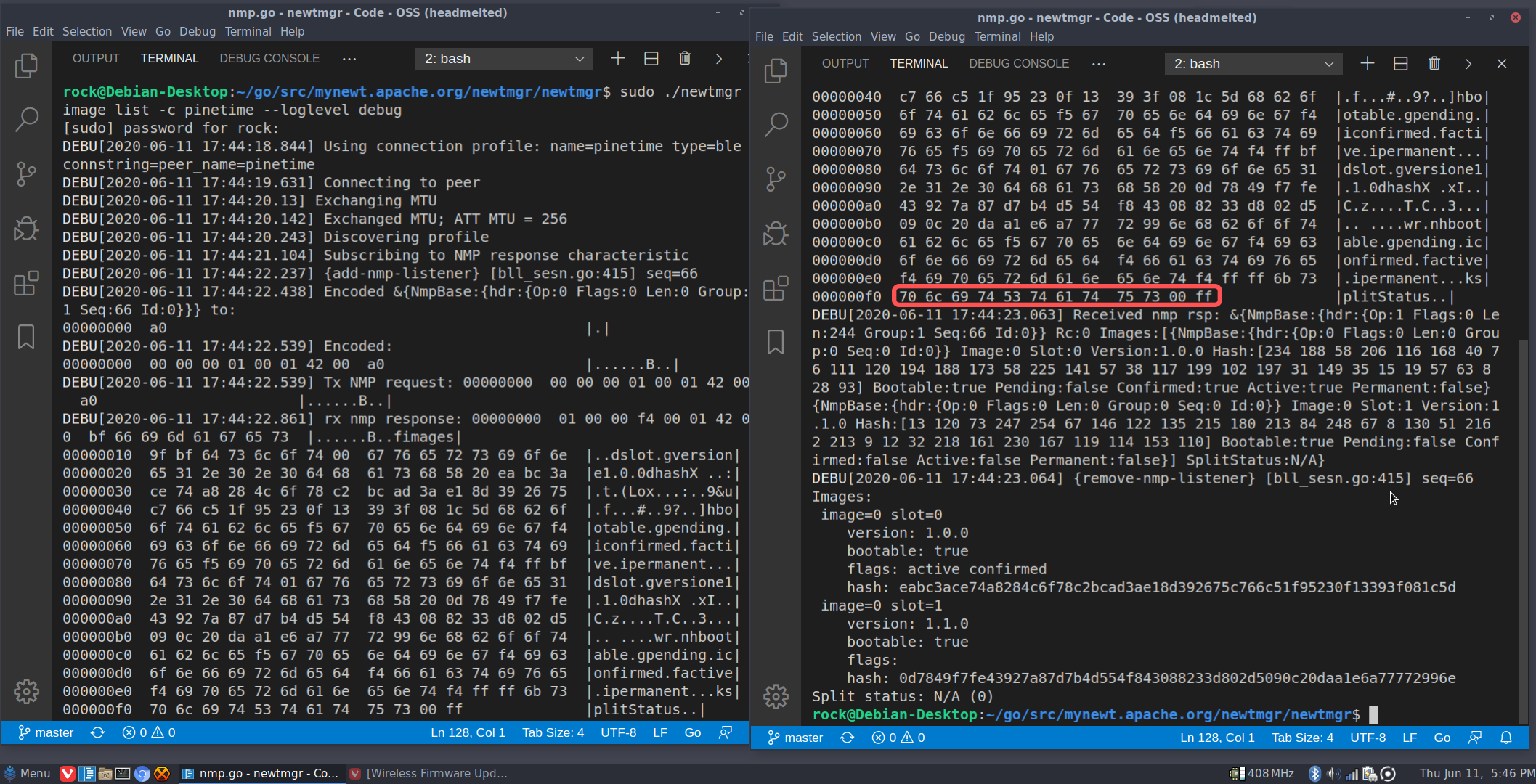
(Which will eventually be dressed up with gotk3, the GTK3 library for Go)
...Was converted line by line to this Flutter app for Android and iOS...
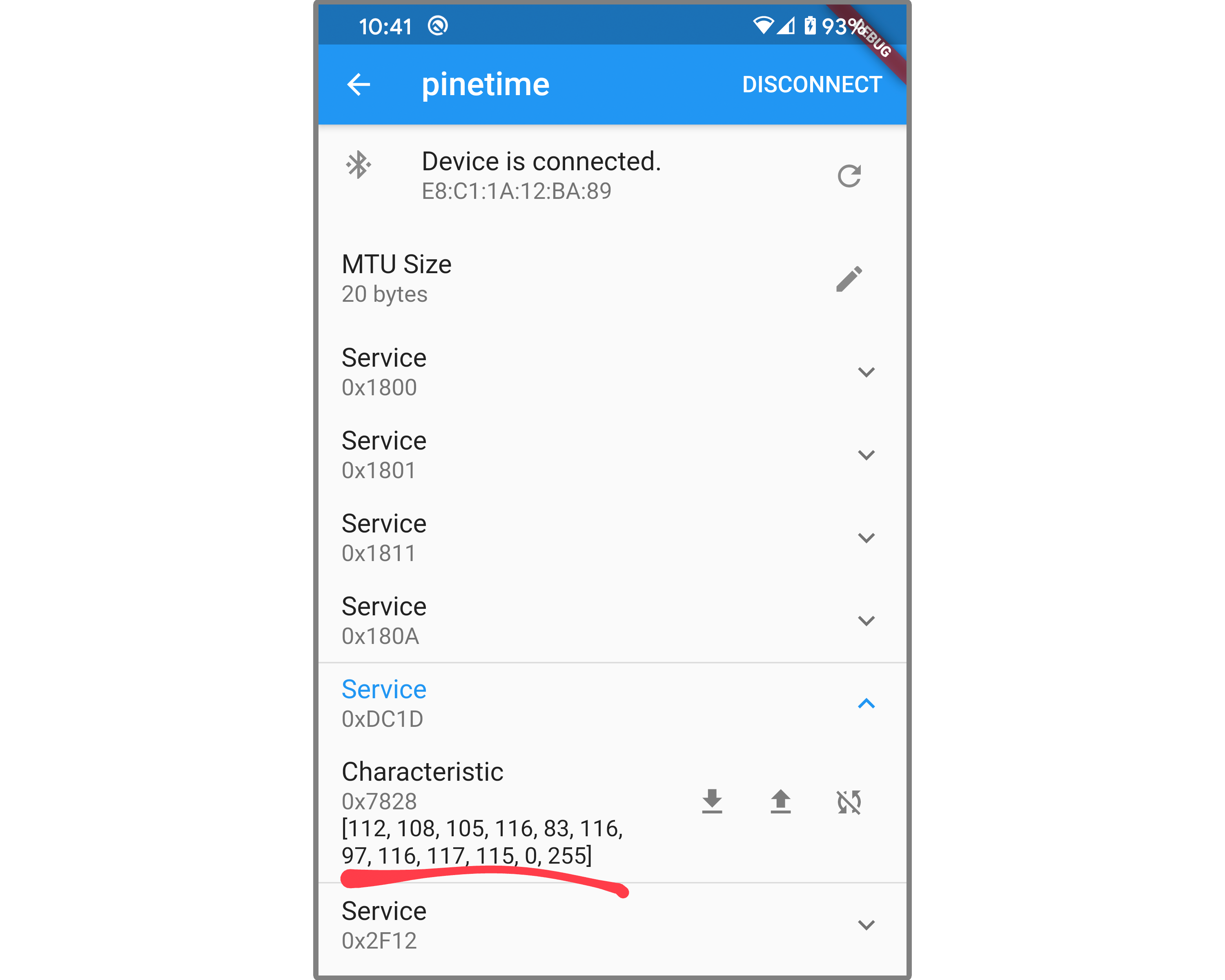
(The highlighted part shows the identical responses returned by PineTime to both apps over Bluetooth LE. So it really works!)
Here's the video demo...
Let's learn to convert this chunk of Go code from nmxact/nmp/nmp.go...
// In Go...
const NMP_HDR_SIZE = 8
/// SMP Header
type NmpHdr struct {
Op uint8 // 3 bits of opcode
Flags uint8
Len uint16
Group uint16
Seq uint8
Id uint8
}
/// Return this SMP Header as a list of bytes
func (hdr *NmpHdr) Bytes() []byte {
buf := make([]byte, 0, NMP_HDR_SIZE)
buf = append(buf, byte(hdr.Op))
buf = append(buf, byte(hdr.Flags))
u16b := make([]byte, 2)
binary.BigEndian.PutUint16(u16b, hdr.Len)
buf = append(buf, u16b...)
binary.BigEndian.PutUint16(u16b, hdr.Group)
buf = append(buf, u16b...)
buf = append(buf, byte(hdr.Seq))
buf = append(buf, byte(hdr.Id))
return buf
}
...To Dart: newtmgr.dart
// In Dart...
const NMP_HDR_SIZE = 8;
/// SMP Header
class NmpHdr {
int Op; // Previously uint8
int Flags; // Previously uint8
int Len; // Previously uint16
int Group; // Previously uint16
int Seq; // Previously uint8
int Id; // Previously uint8
/// Construct an SMP Header
NmpHdr(
this.Op,
this.Flags,
this.Len,
this.Group,
this.Seq,
this.Id
);
/// Return this SMP Header as a list of bytes
typed.Uint8Buffer Bytes() { // Previously returns []byte
var buf = typed.Uint8Buffer();
buf.add(this.Op);
buf.add(this.Flags);
typed.Uint8Buffer u16b = binaryBigEndianPutUint16(this.Len);
buf.addAll(u16b);
u16b = binaryBigEndianPutUint16(this.Group);
buf.addAll(u16b);
buf.add(this.Seq);
buf.add(this.Id);
assert(buf.length == NMP_HDR_SIZE);
return buf;
}
}
How shall we begin the code conversion from Go to Dart?
Add the trailing semicolons (;)
Semicolons are optional in Go, but mandatory in Dart. So every line in Dart needs to terminate with a semicolon. Hence this code in Go...
// In Go...
const NMP_HDR_SIZE = 8
Becomes this code in Dart...
// In Dart...
const NMP_HDR_SIZE = 8;
Flip the names and types of variables
Go puts the variable name before the type name... Dart does it the other way around. Hence this code in Go...
// In Go...
Op uint8
Becomes this code in Dart...
// In Dart...
int Op;
Dart doesn't have specific numeric types like uint8 (unsigned 8-bit integer). So we use int to represent a byte.
We write assertions in Dart to make sure that the int values are indeed bytes...
// In Dart...
assert(val >= 0 && val <= 255); // val must be a byte
We rewrite Go byte arrays []byte as the Dart type typed.Uint8Buffer (from the helper library typed_data)...
// In Go...
// Bytes() is a function that returns a byte array
func (hdr *NmpHdr) Bytes() []byte {
Becomes this...
// In Dart...
// Import the helper library for Byte Buffers: https://pub.dev/packages/typed_data
import 'package:typed_data/typed_data.dart' as typed;
// Bytes() is a function that returns a byte array
typed.Uint8Buffer Bytes() {
Read on for more conversion steps.
These language overview docs are very helpful when converting Go to Dart...
I'm new to Dart and it looks like a mix of Java and JavaScript. But like Go (and unlike JavaScript), Dart is Static Typed with Type Inference, which simplifies the code conversion.
We rewrite a Go struct as a Dart class...
// In Go...
type NmpHdr struct {
Op uint8
...
}
Becomes this...
// In Dart...
class NmpHdr {
int Op;
...
}
We move Go methods inside Dart classes...
// In Go...
type NmpHdr struct {
Op uint8
...
}
// Bytes() method for NmpHdr
func (hdr *NmpHdr) Bytes() []byte { ...
Becomes this...
// In Dart...
class NmpHdr {
int Op;
...
// Bytes() method for NmpHdr
typed.Uint8Buffer Bytes() { ...
}
Go has implicit constructors for structs. We'll have to add Dart constructors like this...
// In Dart...
class NmpHdr {
int Op;
// Constructor for NmpHdr
NmpHdr(
this.Op
);
}
NmpHdr is the common Message Header that we'll be transmit to PineTime (and receive from PineTime) for all our Bluetooth LE messages.
We rewrite a Go interface (nmxact/nmp/nmp.go)...
// In Go...
type NmpReq interface {
Hdr() *NmpHdr
SetHdr(hdr *NmpHdr)
...As a Dart abstract class (newtmgr.dart)
// In Dart...
abstract class NmpReq {
NmpHdr Hdr();
void SetHdr(NmpHdr hdr);
NmpReq is the abstract base class for Request Messages that we'll be transmitting to PineTime over Bluetooth LE.
In some cases, a Go struct should be converted to a Dart mixin. Consider this Go struct defined in nmxact/nmp/nmp.go...
/// In Go...
/// SMP Base Message
type NmpBase struct {
hdr NmpHdr `codec:"-"`
}
/// Get the SMP Message Header
func (b *NmpBase) Hdr() *NmpHdr {
return &b.hdr
}
/// Set the SMP Message Header
func (b *NmpBase) SetHdr(h *NmpHdr) {
b.hdr = *h
}
NmpBase appears to be a base class for Request and Response Messages.
But if we look closely at the above code, NmpBase is actually a helper class for getting and setting the Message Header for Request and Response Messages.
Helper classes are implemented in Dart as a mixin. Here's our mixin implementation of NmpBase in newtmgr.dart...
/// In Dart...
/// SMP Message Helper
mixin NmpBase {
NmpHdr hdr; // Will not be encoded: `codec:"-"`
/// Get the SMP Message Header
NmpHdr Hdr() {
return hdr;
}
/// Set the SMP Message Header
void SetHdr(NmpHdr h) {
hdr = h;
}
}
We use our NmpBase mixin like this (newtmgr.dart)...
/// In Dart...
/// SMP Request Message to Read Image State
class ImageStateReadReq
with NmpBase // Mixin to get and set SMP Message Header
implements NmpReq // Interface for SMP Request Message
{
/// Get the SMP Request Message
NmpMsg Msg() { return MsgFromReq(this); }
/// Encode the SMP Request Message fields to CBOR
void Encode(cbor.MapBuilder builder) {
// Encode an empty body
}
}
How are the Dart message classes and mixins connected?
Like this...
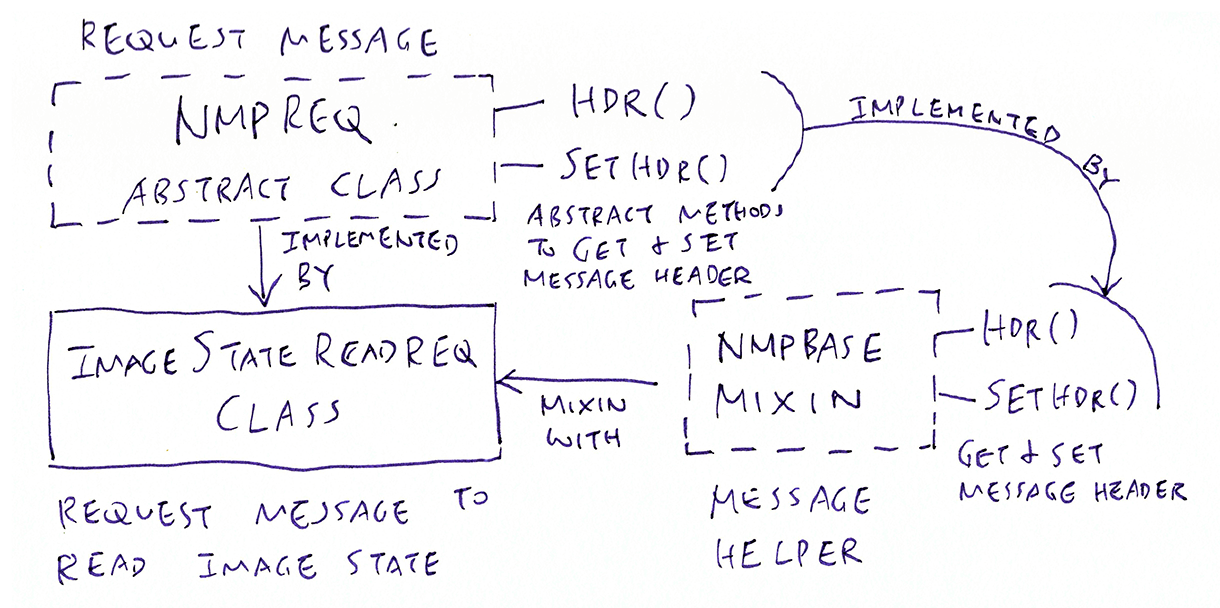
It looks complicated, and yes we need to understand the Go code before converting to Dart.
Go uses "Static Duck Typing" thus it's not obvious whether a Go struct should be a Dart class, abstract class or mixin. But with a bit of practice... We'll get the hang of it!
Let's convert this Go code that creates a byte array and appends some bytes: nmxact/nmp/nmp.go
// In Go: Create a byte array with max size NMP_HDR_SIZE
buf := make([]byte, 0, NMP_HDR_SIZE)
// Append bytes to the array
buf = append(buf, byte(hdr.Op))
buf = append(buf, byte(hdr.Flags))
In Dart we use typed.Uint8Buffer to represent a byte buffer. It works like a Dart List, so we may call add() to add bytes: newtmgr.dart
// In Dart: Create a byte buffer
var buf = typed.Uint8Buffer();
// Append bytes to the byte buffer
buf.add(this.Op);
buf.add(this.Flags);
...
// Verify the buffer has size NMP_HDR_SIZE
assert(buf.length == NMP_HDR_SIZE);
To add a Dart List to another List, we call addAll(): newtmgr.dart
// In Dart: Convert 16-bit length to a list of 2 bytes
typed.Uint8Buffer u16b = binaryBigEndianPutUint16(this.Len);
// Append the 2 bytes to the byte buffer
buf.addAll(u16b);
Now let's probe deeper into the Go code and understand how it sends Bluetooth LE commands to PineTime.
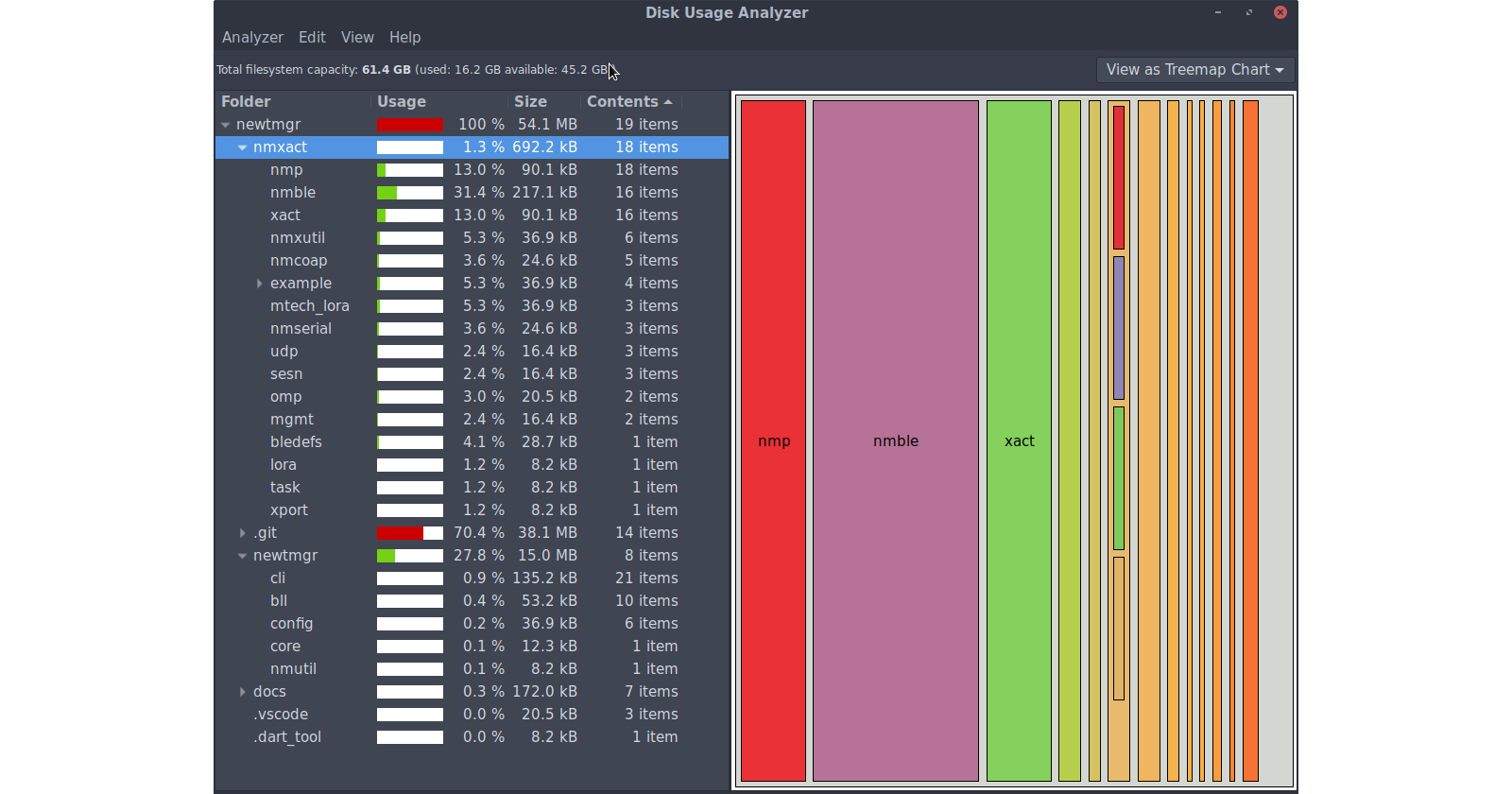
The Go code in this article that connects to PineTime Smart Watch over Bluetooth LE... Where does it come from?
The Go code comes from Newt Manager, the Linux command line tool that updates PineTime's firmware over Bluetooth LE. Newt Manager implements the Simple Management Protocol for talking to PineTime's Firmware Update Service.
Newt Manager has over a hundred Go source files... Which source files should we convert to Dart?
Go Tracing can help! Let's enable Go Tracing like this: newtmgr.go
import "runtime/trace"
func main() {
trace.Start(os.Stderr)
defer trace.Stop()
...
This tells the Go Tracing Library to dump the traces to Standard Error.
Here's how we run Newt Manager to transmit a command to PineTime (list firmware images) and capture the Go Tracing data...
# Install graphviz for Go tracing
sudo apt install graphviz
# For Manjaro and Arch Linux:
# sudo pacman -S graphviz go
# Download Newt Manager
mkdir -p ~/go/src/mynewt.apache.org
cd ~/go/src/mynewt.apache.org/
git clone https://github.com/lupyuen/mynewt-newtmgr
mv mynewt-newtmgr newtmgr
# TODO: Edit the source files to enable Go tracing
# Build Newt Manager
cd ~/go/src/mynewt.apache.org/newtmgr/newtmgr
export GO111MODULE=on
go build
# Run Newt Manager and add connection for PineTime
cd ~/go/src/mynewt.apache.org/newtmgr/newtmgr
sudo ./newtmgr conn add pinetime type=ble connstring="peer_name=pinetime" 2> /dev/null
# Run Newt Manager and list firmware images on PineTime
sudo ./newtmgr image list -c pinetime 2> trace.out
# For Manjaro on Pinebook Pro (and other systems) we may need to specify the Bluetooth HCI interface with `--hci` like this...
# sudo ./newtmgr image list -c pinetime --hci 1 2> trace.out
# Display the captured Go trace in a web browser
go tool trace trace.out
The Go Tracing web page appears, showing the following links...
View trace
Goroutine analysis
Network blocking profile (⬇)
Synchronization blocking profile (⬇)
Syscall blocking profile (⬇)
Scheduler latency profile (⬇)
User-defined tasks
User-defined regions
Minimum mutator utilization
Click Synchronization Blocking Profile to show a highly detailed graph of the Go function calls...
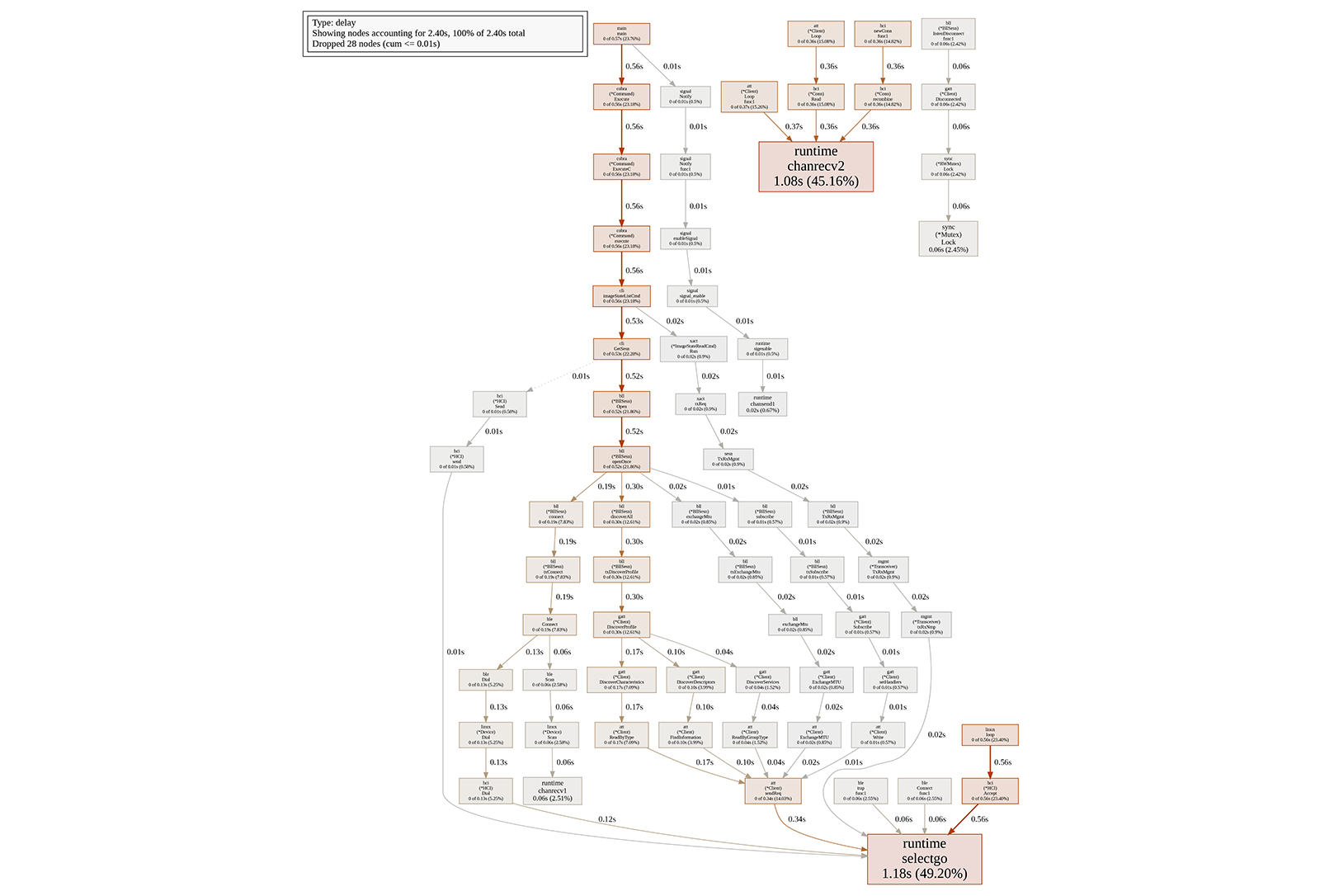
Now we know which Go functions were called to list firmware images on PineTime... But soooo many functions!
Let's eliminate the Go modules bll, ble and the stuff underneath... These Bluetooth LE functions are already implemented in Dart by flutter_blue.
What's remaining is this xact trail of Go function calls...
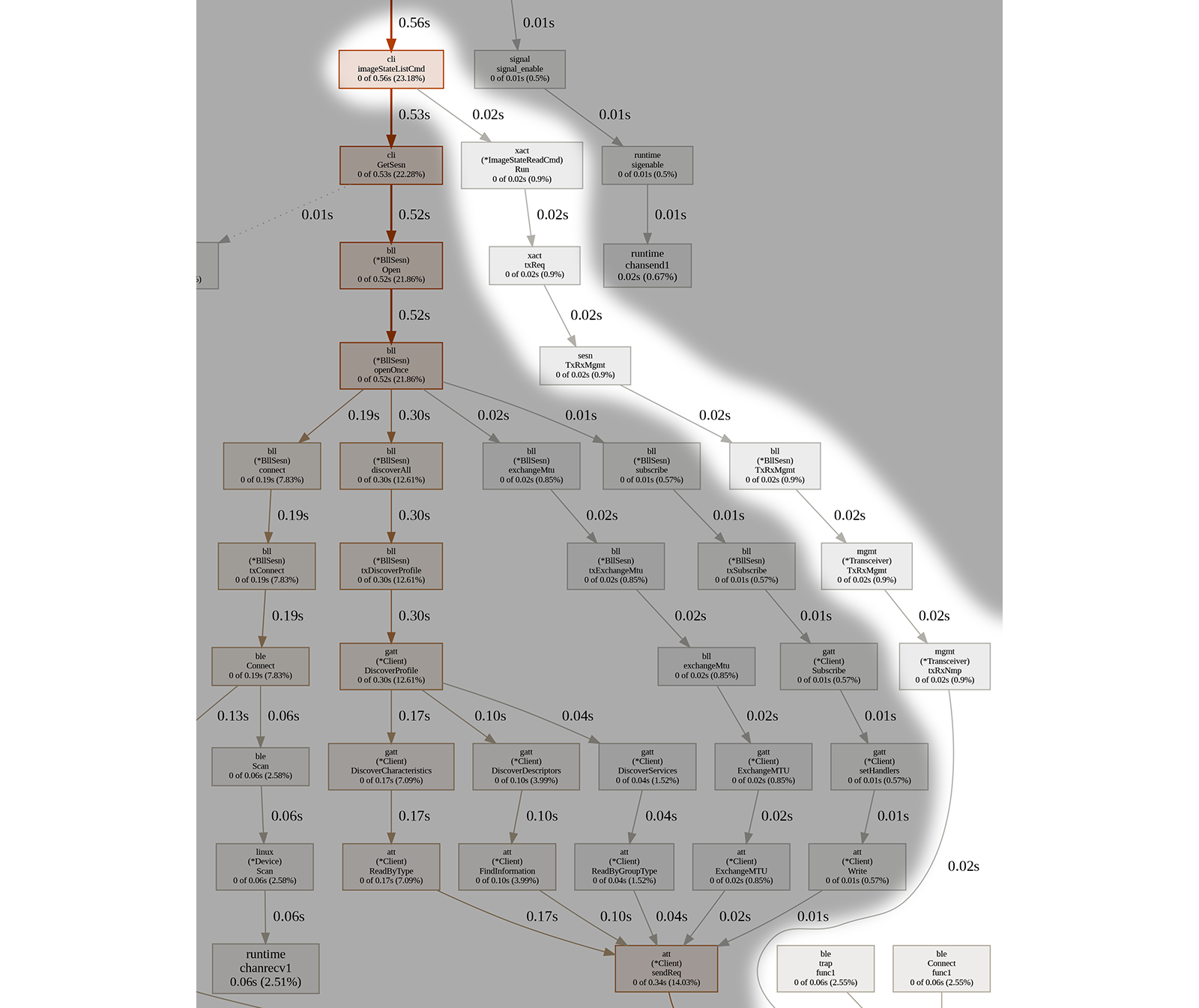
That's why we chose to convert code like ImageStateReadCmd to Dart... Because it was called when Newt Manager connected to PineTime to query its firmware images.
Some functions (like BodyBytes below) may not appear in Go Tracing because they are invoked by Bluetooth callbacks. We may force them to appear in Go Tracing like this...
import (
"context"
"runtime/trace"
"time"
)
func BodyBytes(body interface{}) ([]byte, error) {
_, task := trace.NewTask(
context.Background(),
"nmxact/nmp/nmp.go/BodyBytes"
)
time.Sleep(100 * time.Millisecond)
defer task.End()
...
In the Go Tracing web page, click User-Defined Tasks to see the traces...
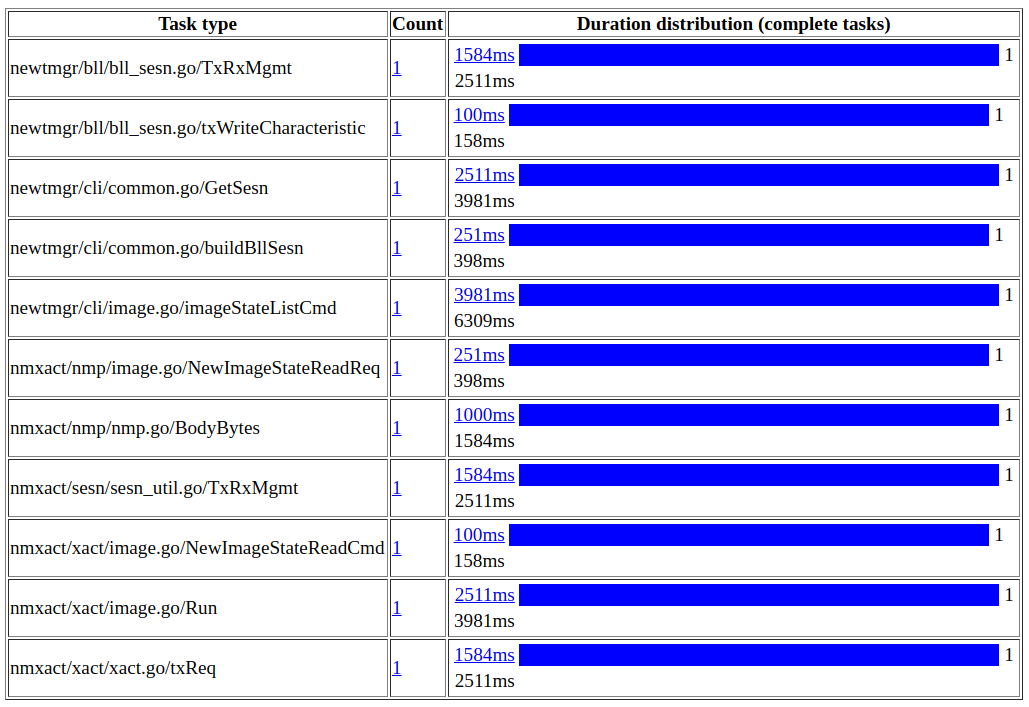
Why did we sleep 100 milliseconds during tracing?
So that we can look at the call duration in the above chart... And figure out which Go function is calling which other function.
There's something odd about the Bluetooth LE messages that we transmit to (and receive from) PineTime...
00000000 bf 66 69 6d 61 67 65 73 | .fimages|
00000010 9f bf 64 73 6c 6f 74 00 67 76 65 72 73 69 6f 6e |..dslot.gversion|
00000020 65 31 2e 30 2e 30 64 68 61 73 68 58 20 70 3e bb |e1.0.0dhashX p>.|
00000030 f8 11 45 8b 1f ad 18 9e 64 e3 a5 e0 f8 09 cb e6 |..E.....d.......|
00000040 ba d8 83 c7 6b 3d d7 12 79 1c 82 2f b5 68 62 6f |....k=..y../.hbo|
00000050 6f 74 61 62 6c 65 f5 67 70 65 6e 64 69 6e 67 f4 |otable.gpending.|
00000060 69 63 6f 6e 66 69 72 6d 65 64 f5 66 61 63 74 69 |iconfirmed.facti|
00000070 76 65 f5 69 70 65 72 6d 61 6e 65 6e 74 f4 ff ff |ve.ipermanent...|
00000080 6b 73 70 6c 69 74 53 74 61 74 75 73 00 ff |ksplitStatus..|
Why is there a mix of ASCII text and binary data in the message?
That's because our Bluetooth LE messages are encoded in Concise Binary Object Representation (CBOR)!
CBOR is like a compact binary form of JSON. The above chunk of data is equivalent to this human-readable JSON...
{
"images": [
{
"slot": 0,
"version": "1.0.0",
"hash": [ 112, 62, 187, 248, 17, 69, 139, 31, 173, 24, 158, 100, 227, 165, 224, 248, 9, 203, 230, 186, 216, 131, 199, 107, 61, 215, 18, 121, 28, 130, 47, 181 ],
"bootable": true,
"pending": false,
"confirmed": true,
"active": true,
"permanent": false
}
],
"splitStatus": 0
}
Comparing their sizes...
CBOR is half the size of JSON! Wow!
In Newt Manager (the Go code that runs on Linux), we encode a Go struct into CBOR like this: nmxact/nmp/nmp.go
// In Go...
// Import the codec library for CBOR Encoding and Decoding: https://godoc.org/github.com/ugorji/go/codec
import "github.com/ugorji/go/codec"
/// Encode SMP Request Body with CBOR and return the byte array
func BodyBytes(body interface{}) ([]byte, error) {
data := make([]byte, 0)
enc := codec.NewEncoderBytes(&data, new(codec.CborHandle))
if err := enc.Encode(body); err != nil {
return nil, fmt.Errorf("Failed to encode message %s", err.Error())
}
log.Debugf("Encoded %+v to:\n%s", body, hex.Dump(data))
return data, nil
}
Here's the equivalent code in Dart that encodes our Dart class into a Bluetooth LE message: newtmgr.dart
// In Dart...
// Import the CBOR Encoder and Decoder library: https://pub.dev/packages/cbor
import 'package:cbor/cbor.dart' as cbor;
/// Encode SMP Request Body with CBOR and return the byte array
typed.Uint8Buffer BodyBytes( // Previously returns []byte
NmpReq body // Previously interface{}
) {
// Get our CBOR instance. Always do this, it correctly initialises the decoder.
final inst = cbor.Cbor();
// Get our encoder and map builder
final encoder = inst.encoder;
final mapBuilder = cbor.MapBuilder.builder();
// Encode the body as a CBOR map
body.Encode(mapBuilder);
final mapData = mapBuilder.getData();
encoder.addBuilderOutput(mapData);
// Get the encoded body
final data = inst.output.getData();
// Decode the encoded body and pretty print it
inst.decodeFromInput();
final hdr = body.Hdr();
print(
"Encoded {NmpBase:{hdr:{"
"Op:${ hdr.Op } "
"Flags:${ hdr.Flags } "
"Len:${ hdr.Len } "
"Group:${ hdr.Group } "
"Seq:${ hdr.Seq } "
"Id:${ hdr.Id }}}} "
"${ inst.decodedToJSON() } "
"to:\n${ hexDump(data) }"
);
// Return the encoded data
return data;
}
Yep the Dart code for encoding CBOR looks longer than Go... And we're not done yet!
For each specific type of message, we need to write Dart code to encode each field of the message.
Here's the request message ImageStateReadReq that we'll be transmitting to PineTime (to query the firmware inside): newtmgr.dart
class ImageStateReadReq
with NmpBase // Get and set SMP Message Header
implements NmpReq // SMP Request Message
{
// No message fields needed
/// Encode the SMP Request fields to CBOR
void Encode(cbor.MapBuilder builder) {
// No message fields needed, so we encode an empty map: {}
}
}
ImageStateReadReq doesn't have any message fields, so the Encode() method is empty. The message is encoded as an empty map: {}
For other messages, the Encode() method will encode the message fields (key and value) like this...
builder.writeString('slot'); // Key
builder.writeInt(0); // Integer Value
builder.writeString('version'); // Key
builder.writeString('1.0.0'); // String Value
builder.writeString('hash'); // Key
builder.writeArray(<int>[112, 62, 187, 248, 17, 69, 139, 31, 173, 24, 158, 100, 227, 165, 224, 248, 9, 203, 230, 186, 216, 131, 199, 107, 61, 215, 18, 121, 28, 130, 47, 181]); // Byte Array Value
This field encoding code is missing from Go because the CBOR Encoder in Go uses Field Tags (like codec:"slot"). Check this for an example of CBOR field encoding in Go: nmxact/nmp/image.go
Now that we have the Dart code to create a CBOR request message for PineTime... Let's test it!
Dart makes testing really easy because Dart programs can be run from the command line.
First we add a main() function that creates a CBOR request message: newtmgr.dart
/// Our Dart program starts jere
void main() {
// Compose a CBOR request for PineTime
composeRequest();
}
/// Compose a request to query firmware images on PineTime
typed.Uint8Buffer composeRequest() {
// Create the SMP Request
final req = NewImageStateReadReq();
// Encode the SMP Message with CBOR
final msg = req.Msg();
final data = EncodeNmpPlain(msg);
return data;
}
Add the dependent libraries to pubspec.yaml...
name: newtmgr
dependencies:
cbor: ^3.2.0 # CBOR Encoder and Decoder. From https://pub.dev/packages/cbor
typed_data: ^1.1.6 # Helpers for Byte Buffers. From https://pub.dev/packages/typed_data
Download the Dart SDK: dart.dev
If we're using 32-bit ARMv7 (like Pinebook Pro or Raspberry Pi), browse to the Dart SDK Archive and download the Linux ARMv7 Dart SDK.
Unzip to ~/dartsdk. Edit ~/.bashrc (or equivalent) and add dartsdk/bin to PATH...
export PATH=$PATH:$HOME/dartsdk/bin
If we're using VSCode: Install the Dart Extension for VSCode
Compile and run our dart program...
pub get
dart newtmgr.dart
We'll see this...
Encoded {NmpBase:{hdr:{Op:0 Flags:0 Len:0 Group:1 Seq:187 Id:0}}} {} to:
a0
Encoded:
00 00 00 01 00 01 bb 00 a0
How did we get the 9 bytes 00 ... a0 for our PineTime request message?
a0 is the CBOR Encoding for the empty Message Body {}. Yep CBOR needs only one byte to encode the two-byte JSON!
The preceding 8 bytes 00 00 00 01 00 01 bb 00 are the Message Header, defined in newtmgr.dart
/// SMP Message Header
class NmpHdr {
int Op; // Previously int8, 3 bits of opcode
int Flags; // Previously uint8
int Len; // Previously uint16
int Group; // Previously uint16
int Seq; // Previously uint8
int Id; // Previously uint8
According to the Simple Managememt Protocol definition from mgmt.h...
| Header Field | Value | Description |
|---|---|---|
Op | 00 | Operation Code (0 for Read Request) |
Flags | 00 | Unused |
Len | 00 01 | Length of Message Body |
Group | 00 01 | Group ID (1 for Image Management) |
Seq | bb | Message Sequence Number (first number is random, subsequent numbers are sequential) |
Id | 00 | Message ID (0 for Image Listing) |
Thus we have created a valid PineTime Request Message that will list the firmware images stored in PineTime.
In a while we'll integrate this tested Dart code into our Flutter mobile app for Android and iOS. And watch happens when we send this Request Message to PineTime over Bluetooth LE!
More about Simple Management Protocol
For more about Dart and Flutter testing, check the Dart Testing Guide
Let's add our new Dart code (for composing PineTime request messages) to the Bluetooth LE Flutter App from our previous article...
"Your First Bluetooth Low Energy App with Flutter"
Here's the new repository for our integrated Flutter App:
github.com/lupyuen/pinetime-companion
We take the Dart code from mynewt-newtmgr/newtmgr.dart and add it to the new repository at pinetime-companion/lib/newtmgr.dart
Let's find the right spot to inject our new code, to compose a PineTime request message and transmit to PineTime: main.dart
/// Screen that displays GATT Services and Characteristics for a Bluetooth LE device
class DeviceScreen extends StatelessWidget {
...
/// Return a list of widgets that renders the GATT Services and Characteristics
List<Widget> _buildServiceTiles(List<BluetoothService> services) {
return services
// For each GATT Service...
.map(
// Render the GATT Service
(s) => ServiceTile(
service: s,
characteristicTiles: s.characteristics
// For each GATT Characteristic...
.map(
// Render the GATT Characteristic and the Read, Write, Notify icons
(c) => CharacteristicTile(
characteristic: c,
/// When the Read icon is pressed: Read the GATT Characteristic
onReadPressed: () => c.read(),
/// When the Write icon is pressed...
onWritePressed: () async {
// Write our PineTime Request Message to the GATT Characteristic
await c.write(_getRequestBytes(), withoutResponse: true);
// Causes read not ready exception:
// await c.read();
},
/// When the Notify icon is pressed...
onNotificationPressed: () async {
// Subcribe to notifications from the GATT Characteristic
await c.setNotifyValue(!c.isNotifying);
// Causes read not ready exception:
// await c.read();
},
The above code renders the GATT Services and Characteristics exposed by PineTime over Bluetooth LE...

In the code above we have set an event handler on the Write icon to transmit our request message to PineTime...
/// When the Write icon is pressed...
onWritePressed: () async {
// Write our PineTime Request Message to the GATT Characteristic
await c.write(_getRequestBytes(), withoutResponse: true);
That's how we transmit requests to PineTime: We write to the GATT Characteristic that's defined by the Simple Management Protocol.
(Simple Management Protocol is exposed by PineTime as Service 8D53DC1D-1DB7-4CD3-868B-8A527460AA84, Characteristic DA2E7828-FBCE-4E01-AE9E-261174997C48, shortened to 0xDC1D and 0x7828 respectively in the screen above)
Tapping the Write icon will trigger our function _getRequestBytes() defined in main.dart
// Import the Dart code for composing PineTime requests
import 'newtmgr.dart';
/// Screen that displays GATT Services and Characteristics for a Bluetooth LE device
class DeviceScreen extends StatelessWidget {
...
/// Compose a PineTime Request Message and return the message bytes
List<int> _getRequestBytes() {
final data = composeRequest();
return data;
}
We have seen composeRequest() in the previous section. This is our new function that composes a PineTime request message.
We add the dependent Dart libraries to pubspec.yaml...
dependencies:
cbor: ^3.2.0 # CBOR Encoder and Decoder. From https://pub.dev/packages/cbor
typed_data: ^1.1.6 # Helpers for Byte Buffers. From https://pub.dev/packages/typed_data
And we're ready to run this on a real phone!
The Flutter code is getting harder to read... And we haven't handled the PineTime response messages yet! How shall we fix this?
We may use the Bloc State Management Library to keep the code modular.
Tapping the icons and handling responses from PineTime may be treated as a stream of events that the Bloc framework will consume to transform the current state. (Think React Redux)
Check out this Flutter App built with Bloc: flutterweathertutorial
Build and run our Flutter Companion App with VSCode...
github.com/lupyuen/pinetime-companion
The steps should be similar to the previous article...
"Your First Bluetooth Low Energy App with Flutter"
Here's the video of our Flutter App running on a real Android phone. The app sends the ImageStateReadReq request to PineTime over Bluetooth LE to query the firmware images stored in PineTime...
Here's the response from PineTime...

The response is truncated because we haven't implemented response processing.
In the demo, why did we subscribe to GATT Notifications from PineTime? Why not just read the GATT Characteristic to get the response from PineTime?
That's how the Simple Managememt Protocol works...
We send a request to PineTime by writing to the GATT Characteristic
Response from PineTime will be returned as a GATT Notification
This kind of Asynchronous Messaging is common for networking apps.
The response from PineTime appears truncated in our unfinished app. What does the entire response look like?
The full response message from PineTime (returned via GATT Notification) looks like this...
00000000 01 00 00 86 00 01 42 00 bf 66 69 6d 61 67 65 73 |......B..fimages|
00000010 9f bf 64 73 6c 6f 74 00 67 76 65 72 73 69 6f 6e |..dslot.gversion|
00000020 65 31 2e 30 2e 30 64 68 61 73 68 58 20 70 3e bb |e1.0.0dhashX p>.|
00000030 f8 11 45 8b 1f ad 18 9e 64 e3 a5 e0 f8 09 cb e6 |..E.....d.......|
00000040 ba d8 83 c7 6b 3d d7 12 79 1c 82 2f b5 68 62 6f |....k=..y../.hbo|
00000050 6f 74 61 62 6c 65 f5 67 70 65 6e 64 69 6e 67 f4 |otable.gpending.|
00000060 69 63 6f 6e 66 69 72 6d 65 64 f5 66 61 63 74 69 |iconfirmed.facti|
00000070 76 65 f5 69 70 65 72 6d 61 6e 65 6e 74 f4 ff ff |ve.ipermanent...|
00000080 6b 73 70 6c 69 74 53 74 61 74 75 73 00 ff |ksplitStatus..|
The response message structure is similar to the request message we have seen earlier...
Message Header: 8 bytes, followed by...
Message Body: Encoded in CBOR
Here's the Message Header according to the definition in mgmt.h...
| Header Field | Value | Description |
|---|---|---|
Op | 01 | Operation Code (1 for Read Response) |
Flags | 00 | Unused |
Len | 00 86 | Length of Message Body |
Group | 00 01 | Group ID (1 for Image Management) |
Seq | 42 | Message Sequence Number (should match the request message) |
Id | 00 | Message ID (0 for Image Listing) |
The message body (in CBOR format) decodes to this JSON...
{
"images": [
{
"slot": 0,
"version": "1.0.0",
"hash": [ 112, 62, 187, 248, 17, 69, 139, 31, 173, 24, 158, 100, 227, 165, 224, 248, 9, 203, 230, 186, 216, 131, 199, 107, 61, 215, 18, 121, 28, 130, 47, 181 ],
"bootable": true,
"pending": false,
"confirmed": true,
"active": true,
"permanent": false
}
],
"splitStatus": 0
}
This is a response from PineTime's firmware update service saying...
I have one firmware image, stored in Slot 0 (Internal Flash ROM)
The firmware version number is 1.0.0
This firmware is active and has been confirmed OK
Can PineTime store a second firmware image?
Yes in Slot 1, which is the Standby Firmware Slot in External SPI Flash. So the above response may contain up to two firmware images.
Slot 1 is used for staging new firmware images during updates, also for rolling back to the old firmware if the new firmware doesn't work.
Why does PineTime's firmware update service return a hash?
The hash will be used in subsequent commands when updating firmware or to roll back the firmware.
The code in this article is part of the upcoming open source PineTime Companion App for Android and iOS. So that we can flash our PineTime Smart Watches wirelessly, sync the date and time, show notifications from our phone, chart our heart rate, ... Maybe even control our smart home gadgets!
We'll be adding more code to the Flutter app...
Response Handling: We shall handle response messages received from PineTime over Bluetooth LE (i.e. handle the GATT Notifications)
Handle Other PineTime Commands: Update firmware, sync date and time, show mobile notifications, ...
State Management with Bloc Library: We shall integrate the Bloc State Management Library to keep the Flutter code modular and maintainable
Companion App for Linux Phones (like PinePhone): We shall take the Newt Manager code in Go and wrap it into a GTK3 app, using the gotk3 library...
If you're keen to help out, come chat with the PineTime FOSS Community (and me) in the PineTime Chatroom!
PineTime Chatroom on Matrix / Discord / Telegram / IRC
Got a question, comment or suggestion? Create an Issue or submit a Pull Request here...
pinetime-rust-mynewt/rust/ app/src/companion.md
"Your First Bluetooth Low Energy App with Flutter"
"Your First GTK App with Go and VSCodium"
"MCUBoot Bootloader for PineTime Smart Watch (nRF52)"
"Firmware Update over Bluetooth Low Energy on PineTime Smart Watch"
"Wireless Firmware Update In Action on PineTime Smart Watch (nRF52)"